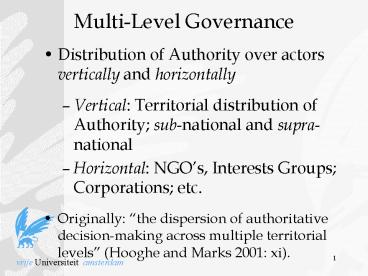MultiLevel Governance PowerPoint PPT Presentation
1 / 22
Title: MultiLevel Governance
1
Multi-Level Governance
- Distribution of Authority over actors vertically
and horizontally - Vertical Territorial distribution of Authority
sub-national and supra-national - Horizontal NGOs, Interests Groups
Corporations etc. - Originally the dispersion of authoritative
decision-making across multiple territorial
levels (Hooghe and Marks 2001 xi).
2
Competing Theories
- Europeanization deepening and broadening
European integration and its effects on national
political systems - State-centrist approach
- Intergovernmentalists national governments did
not loose authority and determine outcomes of
policies - Europeanization ? Multi-Level Governance?
- Europeanization ? Transfer of authority from
national government to sub-national governments?
3
Some concepts
- Federalism
- Ideology but federation central government
incorporates regional units into its decision
procedure on some constitutionally entrenched
basis (King 1984 77) - Regionalism
- Institutionally between unitary and federal
system - Decentralisation
- Process transfer of authority from higher
government levels to lower government levels - Institutionalized comparatively speaking, lower
governmental levels are more authoritative
vis-à-vis higher governmental levels - Devolution
- Same as decentralisation but instead transfer of
authority to a newly established governmental
tier - Deconcentration
- No authority (decision-making) is being
transferred but only the actual provision is
delegated to sub-national field offices
4
Federative arrangementsEvolving complexity in
sub-national and supra-national governmental
relationships
Adapted from Elazar 1991 xvi and 398
5
Evolving complexity in sub-national authority
arrangements
- Some examples from simple to complex federative
arrangements (power sharing) - Austria, Denmark, Serbia and Montenegro, Bosnia
and Herzegovina - Asymmetry units of the same governmental tier
equal powers but except for . - Belgium, Spain
6
Central government
Power sharing
Lander
Austria
Individual
7
Central government
Power sharing
Power sharing
Greenland
Faroer Islands
Amter
Individual
Individual
Individual
Denmark
8
Central government
Power sharing
Serbia
Montenegro
Power sharing
Okruzi
Kosovo
Vojvodina
Individual
Serbia Montenegro
Individual
Individual
Individual
9
Central government
Power sharing
Federacija Bosne
Republika Sprska
Power sharing
Canton 1
Canton 2
Canton 10
Power sharing
Individual
Individual
Brcko district
Bosnia Herzegovina
Individual
10
Asymmetry in Belgium
- 3 Regios / Regions
- Brussels Flanders Walloon
- Authority over transport, planning and economical
policies - 3 Gemeenschappen / Communities
- Flemish French German
- Authority over cultural, language and educational
policies - Asymmetry
- German community has no own regional government
- German community has some policies which are
otherwise under a regional government - Flemish community and region are institutionally
merged
11
Asymmetry in Spain
- Over Time fast track versus slow track
autonomas comunidades - Fast track regions quicker more autonomy
- Cross-sectional historical versus normal
autonomas comunidades - Basque country and Navarre have more tax
authority - Historical regions have authority over more
policies such as labour market policies, health,
and education
12
Increasing complexity needs more sophisticated
measurement
13
Regional Authority Index 0 30
Self-rule 0 20
Shared-rule 0 10
Self-rule
Tax autonomy 0 8
Institutional depth 0 4
Policy scope 0 4
Representation 0 4
Shared-rule
Constitutional change 0 4
Executive policy 0 2
Taxation 0 2
Legislation 0 2
14
Development of Regional Authority in 42
Democracies for 1950-2006
15
Hypotheses for increasing Regional Authority
- Functional
- Population size larger countries need regional
governments - Growth government policy portfolio, especially
welfare state policies - Identity
- Ethnic groups require decentralised policy
provision - Regional parties with a specific autonomy demand
- Democracy
- More self-rule demand inherent with
democratization - Openness system give input for heterogeneous
demands - European integration
- Mobilizes sub-national governments (via
subsidies) and the national government is bypassed
16
Functional Relationship between Regional
Authority and Population Size
17
Functional Relationship between Regional
Authority and Government Personnel
18
Identity Relationship between Regional Party
Strength and Population Size in
West and
East
19
Democracy Relationship between Regional
Authority and the Longevity of the Democratic
Regime
20
EU integration Relationship between Regional
Authority and the number of years being member of
the European Union
21
Multi-Variate Regression AnalysisN 1583 (42
countries) R2adj. 0.63
p lt 0.01 n.s. not significant
22
Multi-Variate Regression Analysis Interpretation
P.s. This analysis is nonsense as I did not
correct for autocorrelation (time dependency due
to time series) and I did not correct for
heteroscedacity (accounting for country
differences). In real scientific life I use
PCSE.

